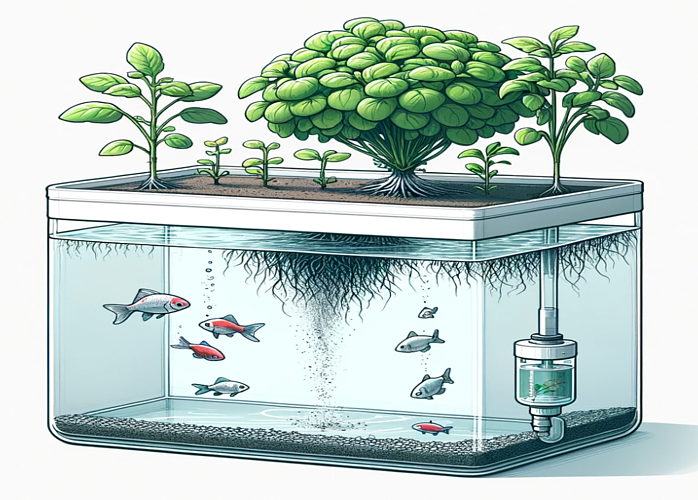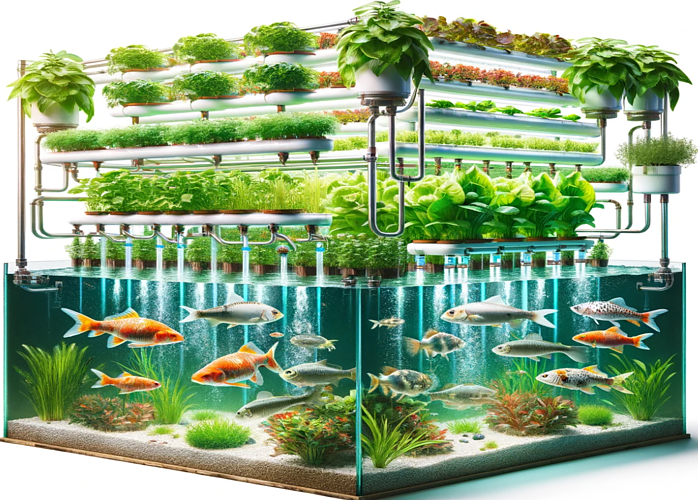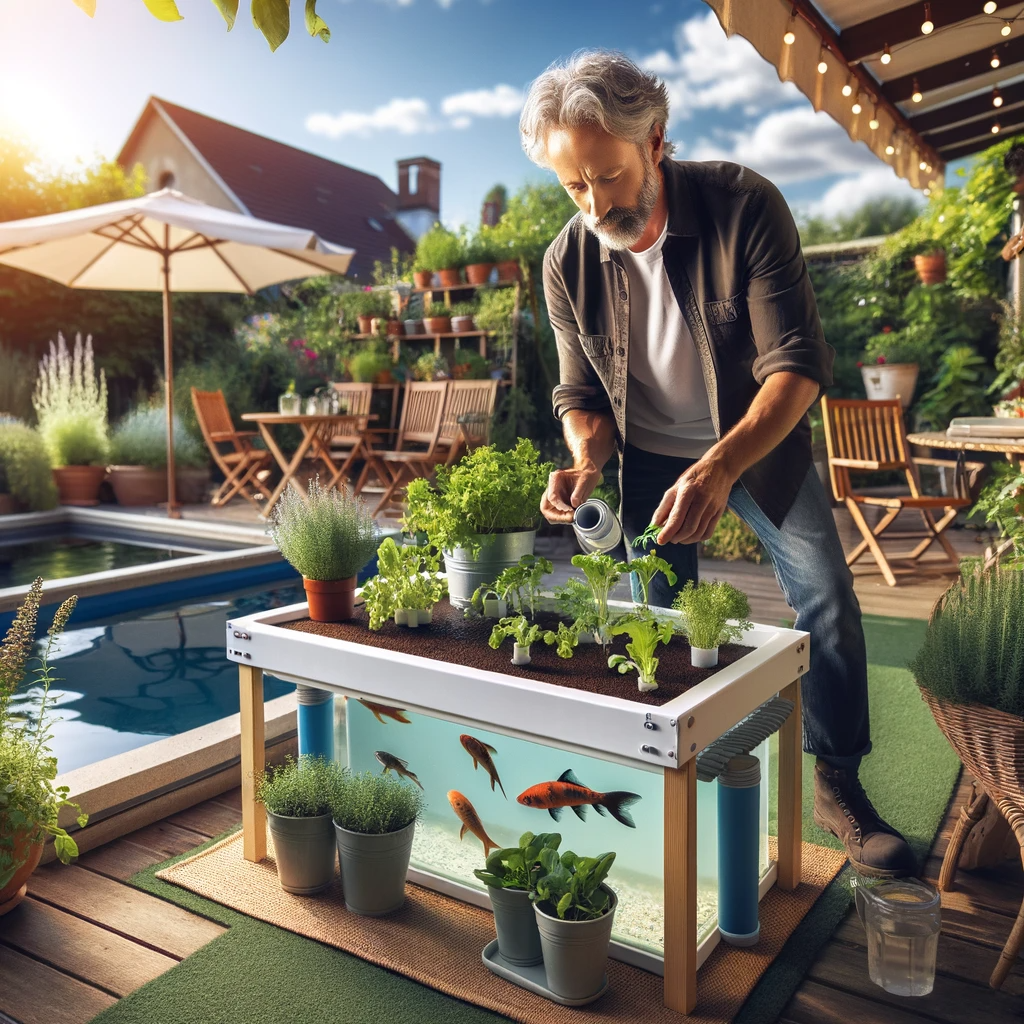 Welcome to the fascinating world of aquaponics, a revolutionary system that merges the best of two worlds: aquaculture (fish farming) and hydroponics (soilless plant cultivation). This innovative approach to gardening and food production is not just a trend; it’s a sustainable solution that’s gaining momentum across the globe. In this post, we’ll look to understand what aquaponics is, how it works, and why it could be the key to a greener, more self-sufficient future. Aquaponics can be scaled up to large scale farming, but this post is an introduction to allow you to think about how you can introduce this technique into your own backyard.
Welcome to the fascinating world of aquaponics, a revolutionary system that merges the best of two worlds: aquaculture (fish farming) and hydroponics (soilless plant cultivation). This innovative approach to gardening and food production is not just a trend; it’s a sustainable solution that’s gaining momentum across the globe. In this post, we’ll look to understand what aquaponics is, how it works, and why it could be the key to a greener, more self-sufficient future. Aquaponics can be scaled up to large scale farming, but this post is an introduction to allow you to think about how you can introduce this technique into your own backyard.
What is Aquaponics?
Aquaponics is an innovative and sustainable method of food production that combines aquaculture (raising fish or other aquatic animals) with hydroponics (growing plants in water without soil). In an aquaponic system, fish and plants grow together in a mutually beneficial relationship. The waste produced by the fish supplies an organic nutrient source for the plants, while the plants help filter and purify the water, which is then recirculated back to the fish tanks. This creates a closed-loop system that is highly efficient, conserving water and removing the need for chemical fertilizers.
The concept of aquaponics is not entirely new; it has roots in ancient civilizations. For example, the Aztecs developed a form of early aquaponics with their “chinampas” or floating gardens, and similar practices were seen in parts of Asia with rice paddies and fish farming. However, the modern form of aquaponics we see today began to take shape in the 1970s with various experimental systems. Since then, technological advances and a growing awareness of sustainable agricultural practices have propelled aquaponics into the spotlight as a practical solution for producing food in an environmentally friendly and efficient manner.
This innovative approach to farming is more than just a merging of techniques; it’s a symbol of a growing movement towards sustainability and self-sufficiency in food production. As we delve deeper into how aquaponics works, you’ll discover its myriad benefits not just for individual households, but for communities and the planet as a whole.
Aquaponics is a synergistic growing technique where fish and plants are grown together in a single, integrated system. This method harnesses the natural relationship between fish and plants to create a sustainable, efficient, and organic ecosystem. Here’s how it works:
Basic Components
An aquaponic system typically consists of three key components:
1. Fish Tank: This is where fish are reared. The type of fish can vary, but common choices include tilapia, trout, and carp. The waste produced by these fish is rich in nitrogen, an essential nutrient for plant growth.
2. Grow Bed: This area is for the plants. Plants are grown in a soilless medium, such as gravel or clay pellets. Water from the fish tank is pumped into the grow beds, carrying with it the nitrogen-rich waste.
3. Water Pump and Pipes: These are crucial for the circulation of water between the fish tank and the grow bed. The pump ensures that the water is continuously flowing, providing plants with nutrients and oxygen while simultaneously cleaning the water for the fish.
The Symbiotic Relationship
In aquaponics, fish and plants work together in harmony:
- The fish produce waste, primarily ammonia.
- Beneficial bacteria in the system naturally convert this ammonia into nitrates, which are excellent nutrients for the plants.
- The plants absorb these nutrients, effectively cleaning and filtering the water.
- The cleansed water is then recirculated back to the fish tank, creating a sustainable loop.
This natural process not only makes the system highly efficient in terms of water usage but also cuts the need for chemical fertilizers, as the fish waste provides all the necessary nutrients for the plants.
Role of Beneficial Bacteria
The unsung heroes of an aquaponics system are the beneficial bacteria. These bacteria perform a process called nitrification, where they convert ammonia from fish waste first into nitrites and then into nitrates, which plants can absorb. This conversion is vital for the health of both the fish (as ammonia in high levels is toxic) and the plants (which require nitrates to grow).

Benefits of Aquaponics
Aquaponics presents a host of benefits that make it an attractive option for sustainable food production, especially in urban areas where space and resources can be limited.
Environmental Sustainability
Aquaponics is a model of environmental sustainability. It uses up to 90% less water than traditional agriculture, as water is recirculated within the system. This makes it especially valuable in areas where water is scarce. Additionally, aquaponics removes the need for chemical fertilizers, as fish waste provides natural nutrients for plant growth, reducing the environmental impact.
Healthy and Organic Produce
This method of growing food not only conserves resources but also yields high-quality, organic produce. The absence of soil reduces the risk of soil-borne diseases, and since no pesticides or herbicides are used, the plants and fish are healthier and safer for consumption.
Space Efficiency in Urban Settings
One of the most significant advantages of aquaponics is its adaptability to urban environments. Unlike traditional farming, which requires vast tracts of land, aquaponics systems can be set up in small spaces like rooftops, balconies, or unused corners in buildings. This makes it an ideal solution for city dwellers looking to grow their own food. Urban aquaponics not only brings fresh, local produce to city residents but also contributes to reducing the carbon footprint associated with transporting food over long distances. Furthermore, these systems can be a part of urban educational initiatives, teaching city residents about sustainable agriculture and healthy eating.
Aquaponics and the Planet
Aquaponics plays a significant role in promoting a more sustainable and eco-friendly approach to food production, which is crucial for the health of our planet.
Reducing Carbon Footprint
By localizing food production, especially in urban settings, aquaponics significantly cuts down the carbon emissions associated with the transport and distribution of food. As cities continue to grow, integrating aquaponics can help reduce the overall carbon footprint of urban centers.
Sustainable Food Production
Aquaponics offers a sustainable alternative to traditional farming and fishing methods, which are often resource-intensive and environmentally damaging. By using a closed-loop system that recycles water and nutrients, aquaponics minimizes waste and maximizes efficiency.
Combating Food Scarcity
In a world where food scarcity is an increasing concern, especially in urban areas, aquaponics presents a viable solution. It can produce a constant supply of fresh produce and fish, regardless of the external environment or climate conditions. This resilience makes it an essential tool in the fight against food insecurity, particularly in urban settings where access to fresh, affordable produce can be challenging.
Self-Sustaining Systems
Aquaponics is not just a method of food production; it’s a model for self-sustainability, especially when integrated with renewable energy sources.
Integration with Renewable Energy
One of the most exciting aspects of aquaponics is its compatibility with renewable energy sources, such as solar panels. By powering pumps and other system components with solar energy, an aquaponics setup can operate independently of the grid. This not only reduces electricity costs but also enhances the system’s sustainability credentials.
Automation in Aquaponics
Modern technology has opened doors to automating various elements of an aquaponics system, such as feeding, water level control, and monitoring of pH and nutrient levels. This automation can make keeping an aquaponic system more manageable, especially for urban dwellers who might not have extensive gardening experience.
Cycle of Self-Sufficiency
The self-sustaining nature of aquaponics lies in its closed-loop system. Fish feed the plants, plants clean the water for the fish, and renewable energy powers the system, creating a cycle of self-sufficiency. This model is particularly appealing in urban settings where space and resources are limited, offering a glimpse into future self-sustaining urban food production.
Getting started
Embarking on an aquaponics journey can be both exciting and daunting. Here’s a brief guide to getting started:
Basic Requirements
To set up a small-scale aquaponic system, you’ll need a fish tank, a grow bed, a water pump, and plumbing. The size of the system can vary based on available space and budget.
Considerations for Urban Aquaponics
In an urban environment, space is a primary consideration. Balconies, rooftops, and small backyards can all be suitable locations. It’s essential to consider the type of fish and plants that will thrive in your climate and environment. Beginners might start with hardy fish like tilapia and easy-to-grow plants like lettuce or herbs.
For Further Information
If you are interested in more information about setting up an Aquaponics system, click here

